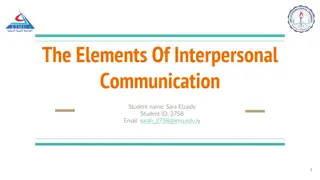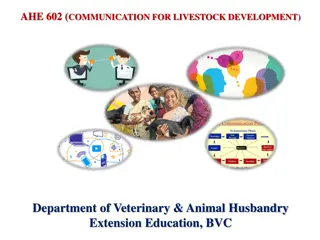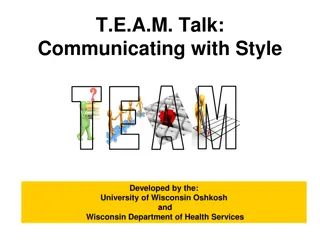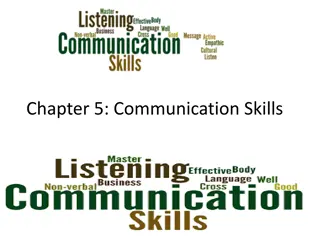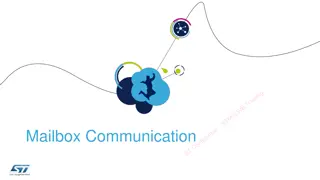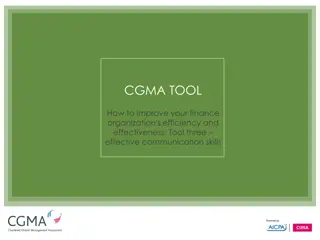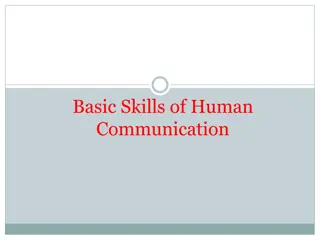Understanding Communication Skills and Types
Communication is the exchange of information through various mediums like speaking and writing. It can be verbal or non-verbal. Verbal communication involves oral and written forms, while non-verbal communication includes body language and appearance. Each type has its own advantages and drawbacks, with written communication being more formal and reliable. Key differences between oral and written communication include literacy requirements, speed, and record-keeping.
Download Presentation

Please find below an Image/Link to download the presentation.
The content on the website is provided AS IS for your information and personal use only. It may not be sold, licensed, or shared on other websites without obtaining consent from the author. Download presentation by click this link. If you encounter any issues during the download, it is possible that the publisher has removed the file from their server.
E N D
Presentation Transcript
Communication Skills By Rohma Mumtaz
What is Communication Definition: The imparting or exchanging of information by speaking, writing, or using some other medium. The process by which information is transmitted between individuals and organizations
Kinds of Communication Verbal Communication: Verbal communication is to communicate either orally or through written form. Non Verbal Communication: To communication or convey the information without using spoken words. Non verbal communication is subdivided into further; Body language Appearance Environmental characters
Verbal Communication: Definition of Oral Communication Oral Communication is the process of conveying or receiving messages with the use of spoken words. This mode of communication is highly used across the world. Oral communication can either be in the form of direct conversation between two or more persons like face to face communication, lectures, meetings, seminars, group discussion, conferences, etc. or indirect conversation, i.e. the form of communication in which a medium is used for interchange of information like telephonic conversation, video call, voice call, etc Definition of Written Communication The communication in which the message is transmitted in written or printed form is known as Written Communication. It is the most reliable mode of communication, and it is highly preferred in the business world because of its formal and sophisticated nature. The various channels of written communication are letters, e-mails, journals, magazines, newspapers, text messages, reports, etc.
There are a number of advantages of written communication which are as under: Referring the message in the future will be easy. The chances of misinterpretation of message are very less because the words are carefully chosen. The communication is planned. Legal evidence is available due to the safekeeping of records. Drawbacks: But as we all know that everything has two aspects, same is the case with written communication as the communication is a time consuming one. Moreover, the sender will never know that the receiver has read the message or not. The sender has to wait for the responses of the receiver. A lot of paperwork is there, in this mode of communication
Key Differences Between Oral Communication and Written Communication The following are the major differences between oral communication and written communication: The pre-condition in written communication is that the participants must be literate whereas there is no such condition in case of oral communication. Proper records are there in Written Communication, which is just opposite in the case of Oral Communication. Oral Communication is faster than Written Communication. The words once uttered cannot be reversed in the case of Oral Communication. On the other hand, editing of the original message is possible in Written Communication. Misinterpretation of the message is possible in Oral Communication but not in Written Communication. In oral communication, instant feedback is received from the recipient which is not possible in Written Communication.
Conclusion Oral Communication is an informal one which is normally used in personal conversations, group talks, etc. Written Communication is formal communication, which is used in schools, colleges, business world, etc. Choosing between the two communication mode is a tough task because both are good at their places. People normally use the oral mode of communication because it is convenient and less time-consuming. However, people normally believe in the written text more than what they hear that is why written communication is considered as the reliable method of communication.
Non Verbal Communication a: Appearance: Personal appearance: it includes hairstyle, dressing code, neatness and manners of person reveals the occupation, age, nationality, social and economic status of a person. Appearance of message: Appearance of an envelop effects the mind of the reader. The color of envelop shows either it is official, non official, local, national or foreign letter. b: Body language: it includes facial expressions, gestures, smell, touch, voice and sounds. Facial expressions: anger , confusion, joy, fear, surprise etc Gestures: it includes Sign language and Para language.
Sign language: A traffic police controls the whole trrafic by doing gestures and movements of his body. Para language: The language of dumb people. Fragrances also conveys the emotions of the sender and arose response in decoder. Touching shows friendship, love, anger and hatred. Voices and Sounds includes whistling, throat clearing, sighing etc c) Environmental Characters: Silence: A short silence after an oral request reveals thinking over it and longer one shows rejection and in some culture it shows consent Time: Quick reaction shows interest while delaying on any part shows lack of interest. Space: It suggests affection, friendship or hatred.
Components of Communication Context Sender/Encoder Message Medium/Channel Receiver/Decoder Feedback Context The surrounding in which communication or conversation takes place is known as context. A sender can communicate his ideas effectively by considering all aspects of context mentioned above.
Sender/Encoder Encoder is the person who sends message. In oral communication the encoder is speaker, and in written communication writer is the encoder. An encoder uses combination of symbols, words, graphs and pictures understandable by the receiver, to best convey his message in order to achieve his desired response. Message Message is the information that is exchanged between sender and receiver. The first task is to decide what you want to communicate and what would be the content of your message; what are the main points of your message and what other information to include. The central idea of the message must be clear. While writing the message, encoder should keep in mind all aspects of context and the receiver .
Medium Medium is the channel through which encoder will communicate his message. How the message gets there. Your medium to send a message, may be print, electronic, or sound. Medium may be a person as postman. The choice of medium totally depends on the nature of you message . Receiver/Decoder The person to whom the message is being sent is called receiver / decoder . Receiver may be a listener or a reader depending on the choice of medium by sender to transmit the message.
Feedback Response or reaction of the receiver, to a message, is called feedback . Feedback may be written or oral message, an action or simply, silence may also be a feedback to a message.



